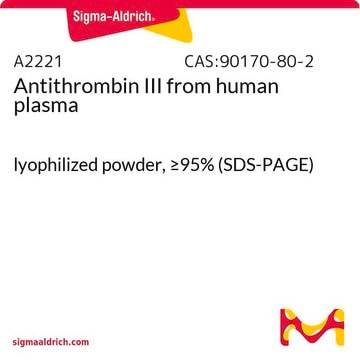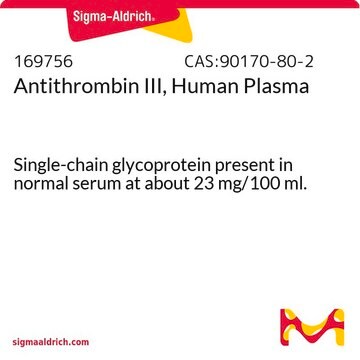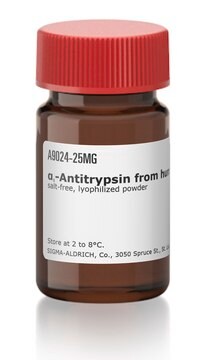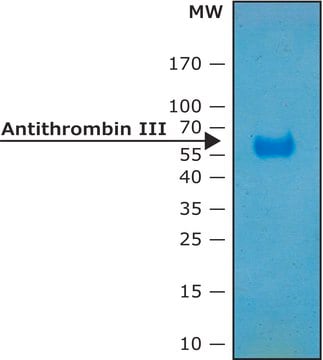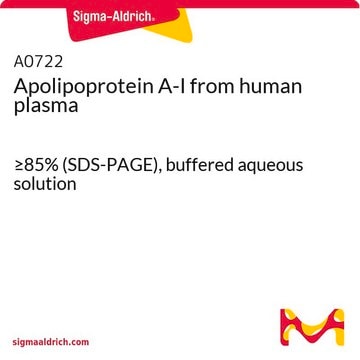SRP6316
Antithrombin III from human plasma
≥95% (SDS-PAGE)
Synonym(s):
SERPINC1
Sign Into View Organizational & Contract Pricing
All Photos(1)
About This Item
UNSPSC Code:
12352202
NACRES:
NA.32
Recommended Products
biological source
human
assay
≥95% (SDS-PAGE)
form
lyophilized
mol wt
58 kDa
packaging
pkg of 100 μg
pkg of 500 μg
UniProt accession no.
shipped in
wet ice
storage temp.
−20°C
Gene Information
human ... SERPINC1(462)
General description
SerpinC1, also known as antithrombin III (AT III), is a member of the serpin superfamily of serine protease inhibitors. The gene is mapped to human chromosome 1. SerpinC1 is a glycoprotein with three β-sheets and nine α-helices. The protein has an active site region and a heparin binding site.
Biochem/physiol Actions
SerpinC1, also known as antithrombin III (AT III), has been found to be a marker for disseminated intravascular coagulation (DIC) and to be of prognostic significance in septic patients. Antithrombin III synthesized in the liver is the principal plasma serpin of blood coagulation proteases and inhibits thrombin and other factors such as Xa by the formation of covalently linked complexes. Thus, it is one of the most important coagulation inhibitors and the fundamental enzyme for the therapeutical action of heparin. The inhibitory activity of AT III undergoes a dramatic increase in the presence of heparin and other glycosaminoglycans. Antithrombin III mediates the promotion of prostaglandin release, an inhibitor of leucocyte activation and downregulation of many proinflammatory cytokines. It exerts anti-inflammatory properties in addition to its anti-coagulative mechanisms. The deficiency or functional abnormality of AT III may result in an increased risk of thromboembolic disease, such as deep vein thrombosis and pulmonary embolism. In addition, it has been reported that AT III can alter or influence inflammatory processes via inhibition of NF (nuclear factor)-κB activation or actin polymerization. It is found in normal serum at 15mg/100mL. Found at higher levels in plasma than in serum because of complexing with thrombin during coagulation. Clinically, reduced levels are indicative of hypercoagulability. Reduction in the levels of antithrombin III enhances the severity of renal ischemia/reperfusion injury.
Physical form
Lyophilized from 50 mM Tris-HCl, pH 8.0, with 150 mM NaCl.
Reconstitution
In water or aqueous buffer
Storage Class
13 - Non Combustible Solids
wgk_germany
nwg
Certificates of Analysis (COA)
Search for Certificates of Analysis (COA) by entering the products Lot/Batch Number. Lot and Batch Numbers can be found on a product’s label following the words ‘Lot’ or ‘Batch’.
Already Own This Product?
Find documentation for the products that you have recently purchased in the Document Library.
Customers Also Viewed
Antithrombin III inhibits nuclear factor kappaB activation in human monocytes and vascular endothelial cells.
Oelschlager C, et al.
Blood, 99, 4015-4020 (2002)
The anti-inflammatory properties of antithrombin III: new therapeutic implications.
Okajima K and Uchiba M
Seminars in Thrombosis and Hemostasis, 24, 27-32 (1998)
Antithrombin III supplementation in severe sepsis: beneficial effects on organ dysfunction.
Inthorn D, et al.
Shock, 8, 328-334 (1997)
Plasma antithrombin III and thrombin generation time: correlation with hemoglobin A1 and fasting serum glucose in young diabetic women.
Sowers JR, et al.
Diabetes Care, 3, 655-658 (1980)
Laboratory tests for antithrombin deficiency.
Khor B and Van Cott EM
American Journal of Hematology, 85, 947-950 (2010)
Our team of scientists has experience in all areas of research including Life Science, Material Science, Chemical Synthesis, Chromatography, Analytical and many others.
Contact Technical Service